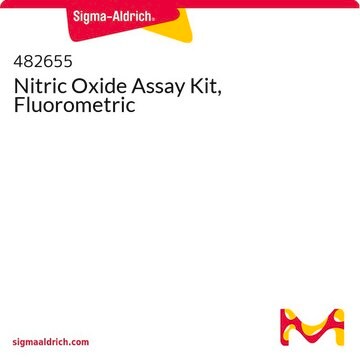G4410
Griess reagent (modified)
Synonym(s):
Greiss, nitrite assay
Sign Into View Organizational & Contract Pricing
All Photos(1)
About This Item
Recommended Products
form
powder
usage
10 g
General description
Griess reagent is based on Griess reaction. The components include naphthylethylenediamine dihydrochloride suspended in water and sulphanilamide in phosphoric acid. This reagent reacts with nitrite in samples to form a purple azo product, absorbance of which is measured at 546 nm.
Application
Griess reagent (modified) has been used:
- in the nitrite assay of primary spinal cord glial cells stimulated with supernatant of damaged sensory neuron (SDSN)
- for measuring nitrite/nitrate oxidized from nitric oxide in stimulated chondrocytes
- for measuring nitric oxide (NO) degradation in RAW264.7 macrophage cells
- to measure the concentration of nitric oxide(NO) in the conditioned media from cultured macrophages (MΦs)
- to determine the relative levels of NO released by BEAS-2B bronchial cells in the culture supernatants
Signal Word
Danger
Hazard Statements
Precautionary Statements
Hazard Classifications
Eye Dam. 1 - Skin Corr. 1
Storage Class Code
8A - Combustible corrosive hazardous materials
WGK
WGK 2
Certificates of Analysis (COA)
Search for Certificates of Analysis (COA) by entering the products Lot/Batch Number. Lot and Batch Numbers can be found on a product’s label following the words ‘Lot’ or ‘Batch’.
Already Own This Product?
Find documentation for the products that you have recently purchased in the Document Library.
Customers Also Viewed
Analysis of nitrate, nitrite, and [15N] nitrate in biological fluids
Green LC, et al.
Analytical biochemistry, 126(1), 131-138 (1982)
Effects of pleiotrophin, a heparin-binding growth factor, on human primary and immortalized chondrocytes
Pufe T, et al.
Osteoarthritis and Cartilage, 15(2), 155-162 (2007)
Praveen Papareddy et al.
The Journal of biological chemistry, 285(36), 28387-28398 (2010-07-02)
Tissue factor pathway inhibitor (TFPI) inhibits tissue factor-induced coagulation, but may, via its C terminus, also modulate cell surface, heparin, and lipopolysaccharide interactions as well as participate in growth inhibition. Here we show that C-terminal TFPI peptide sequences are antimicrobial
The C-terminal sequence of several human serine proteases encodes host defense functions
Kasetty G, et al.
Journal of Innate Immunity, 3(5), 471-471 (2011)
A critical role of toll-like receptor 2 in nerve injury-induced spinal cord glial cell activation and pain hypersensitivity
Kim D, et al.
The Journal of Biological Chemistry, 282(20), 14975-14983 (2007)
Our team of scientists has experience in all areas of research including Life Science, Material Science, Chemical Synthesis, Chromatography, Analytical and many others.
Contact Technical Service








